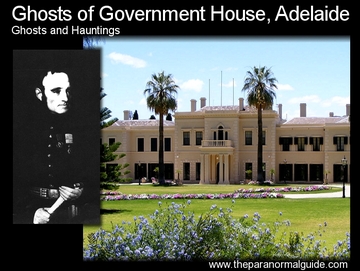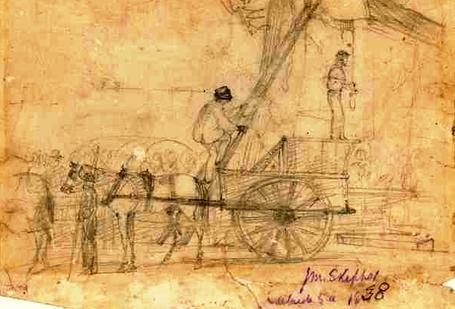
Is the spirit that of a previous Governor, an unidentified person found dying on the property, or someone else?
The bodies of several executed criminals lay near the house. Could it be one of those who are said to haunt the property?
Murder
 The Advertiser Feb 5th, 1862.
The Advertiser Feb 5th, 1862. Although there are quite a number of deaths linked to the house, none are quite as tragic as the two we shall look at here.
In 1862, Sir Richard MacDonnell had departed (for a new appointment as Governor of Nova Scotia), and there was a sale of his belongings held within the ballroom of Government House. Inspector Pettinger was on duty, overseeing the security of the sale, as dozens of people descended upon the building in hopes of picking up a good price on some fantastic furniture and other items.
Some of MacDonnell's effects were also stored in one of the bedrooms, and as the eager crowd moved from the Ballroom to the bedroom, a man by the name of John Seaver shot Inspector Pettinger. Pettinger's head was shattered as the shot passed into his skull, and he soon died. John Seaver had only recently been discharged from the police force. He was found guilty of the murder and hanged in Adelaide Gaol.
Tragedy
One day, as Harriet was being undressed for her bath, the nurse (her carer/nanny) was quickly called on other business. Soon, Harriet's screams brought the nanny back. The site which greeted her was appalling - Harriet had overbalanced and fallen into the tub of scalding hot water.
She was quickly taken to her room, but unfortunately, doctors could do nothing for Harriet, who lingered in agony for several days, before succumbing to her injuries. There is a window above the organ of St Pauls Cathedral that acts as a silent memento to poor Harriet Musgrave.
There have been other deaths within Government House, but if we go back in time we can find a few more linked to the property...
Gaol
 Adelaide's first permanent gaol.
Adelaide's first permanent gaol. South Australia is unique as a freely settled, planned British province, unlike the other states which are convict settled. For this reason, it was decided that a gaol was unnecessary, in that abiding by the law would be simple common sense for the free people. In 1836 there were few prisoners, and these were held on transport ships, including the HMS Buffalo (a replica of which can be seen on the Patawalonga River, and serves as a restaurant). Longer serving prisoners would be sent to the eastern colonies, namely Sydney and Tasmania.
The Seamen that worked the Buffalo, were the people responsible for the construction of the first Governors Hut. This was built close to where the north west corner of the wall surrounding government house is located today. Being proud sailors, they refused help from outside hands and soon Governor Hindmarsh had a small three roomed mud and thatched hut.
As the colony grew, and the transport ships, including the Buffalo, moved on, it was soon seen that a better solution for holding prisoners would be required. At first, prisoners were held in an encampment located within the (now) Botanic Gardens, and were held under guard and chained to a tree.
This prison accommodation was soon upgraded to a tent, with a yard for the prisoners marked out with a simple rope boundary. Prisoners were allowed to move about, but not too freely as they were still chained to a heavy log. No blankets were given to the prisoners, even during the winter nights.
In January 1938, Adelaide's first purpose built lock-up was constructed, built by the marines (left behind from the transport ships in order to guard the prisoners - much to their annoyance) and the prisoners. This first 'temporary' Gaol was made up of two rooms, no larger than ten by twelve feet, and was constructed of stringy bark logs with shingled roofs, and dirt floors. The two rooms were surrounded by a wooden palisade.
The gaol was built to accommodate eight prisoners, and was built within quick walking distance east of the Governors Hut, so the marines could both work guarding prisoners and the Governor. In today's terms, the location of this gaol is the north east corner of the government house property.
Execution
 The Execution of Michael Magee.
The Execution of Michael Magee. It is safe to say the execution did not go as planned. Michael Magee was brought to the site of his execution, a tree near the base of Montefiore Hill North Adelaide, riding his plain timber coffin on a cart pulled by two horses. After the noose was set, and the cap drawn over his face, the executioner gave the signal for the horses to take off, dropping Magee into eternity.
Unfortunately the horses only took a leisurely pace and Magee slowly slid off the cart. He had been so badly tied up he was able to reach his hands above his head and pull on the rope relieving the stress on his neck. He uttered excruciating cries of 'oh god, oh Christ save me' and 'Christ have mercy upon me!'.
The crowd was horrified and urged the marines to cut him down, others urged the marines to shoot him with their muskets. The hang man had ridden off, but was soon brought back under command of the police. Jack Ketch, in all his executioner garb and disguise, launched himself at the still struggling Magee and swung off the dying man's legs. Ketch kept his position on Magees legs for thirteen minutes and even after that Magee still lived. However the work was done, Magee had no more strength to pull on the rope and slowly the work was finished. Magee was buried within the grounds of the Gaol and South Australia's first execution was complete.
Four more burials of executed prisoners took place within the palisade of the Gaol, two white men and 'two natives'. These four burials were all very close to one another, and hinted not near where Magee was interred into the ground.
Three years, later in 1841, Adelaide Gaol was built, and the old gaol near Government House was all but demolished. Governor Gawler had replaced Hindmarsh in 1838, and ordered the construction of a new masonry building to replace the old governors hut. The earliest part of the Governors new residence, the east wing, was completed and occupied in May 1940. Governor Gawler went back to England in 1841, and his successor governors all chose to spend the least amount of time possible in the building.
Discovery
 Government House today.
Government House today. However, through later research the remains can almost be certainly attributed to one of the executed prisoners. Being as the remains were found along with boots, the two aboriginal executions can be ruled out, as can the other two white men buried next to each other, as no other bones were found in the vicinity. This leaves only Michael Magee. It is not known whether the bones were interred in the ground there, taken to a cemetery or ended up in a collection somewhere.
Regardless, fifty years after his botched execution, Michael Magees bones were disturbed. Could Michael Magee be the spirit responsible for the haunting at Government House?





 RSS Feed
RSS Feed
